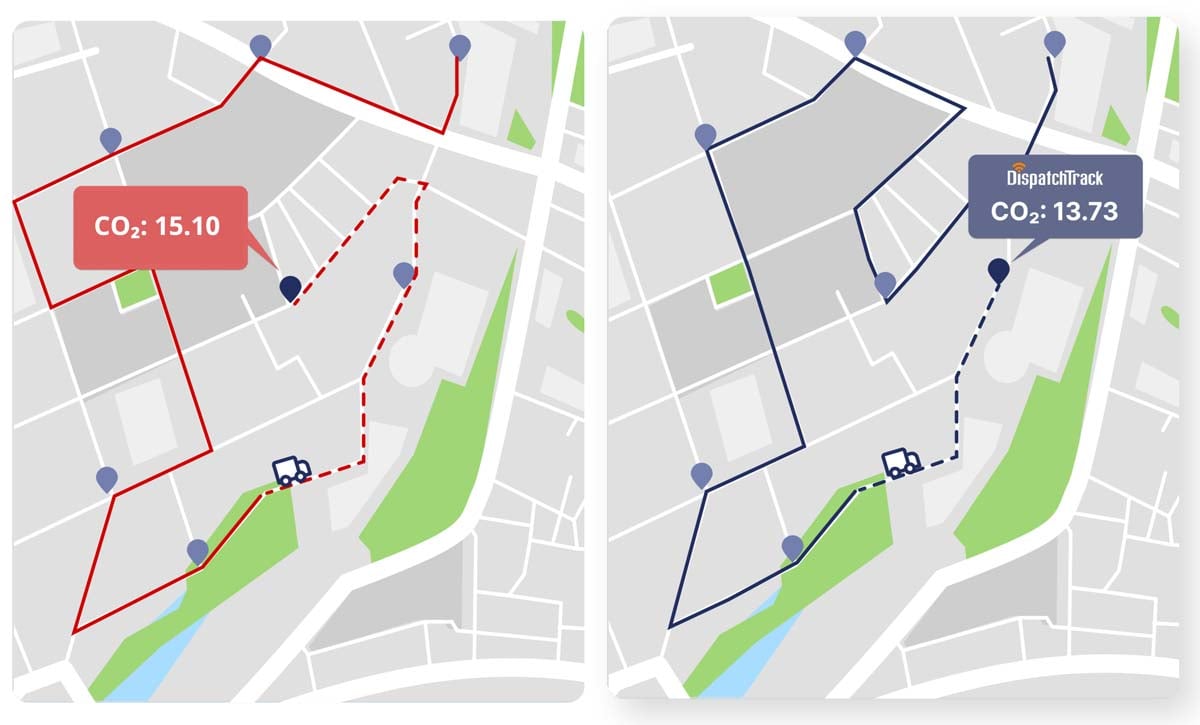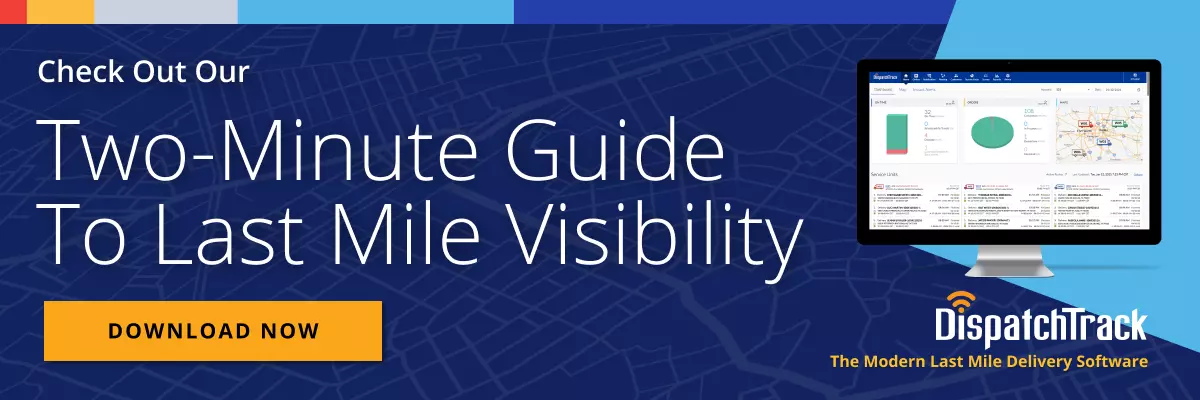When logistics professionals think about obstacles to going green in the last mile, a number of hurdles probably come to mind: accurately measuring CO2 output, finding electric vehicles, etc. But what about cost?

We’d be willing to bet that many businesses, faced with the desire to make their operations more sustainable, are slowed down by thinking that reducing their CO2 output is going to be too expensive to be feasible—especially in markets where margins are razor-thin and volatile demand makes any big changes risky.
It’s an understandable reaction—but it’s also a serious misconception. While many of the investments required to reduce your carbon footprint will be just that—investments—many of the tactics that you can adopt right now to try and immediately impact your sustainable initiatives can actually go hand in hand with saving money.
How is this possible? The simple answer is that powering more efficient operations overall is also one of the keys to becoming more carbon-efficient in particular. In other words, when everything goes right in the last mile, it’s actually better for the planet.
How Do You Make the Last Mile More Efficient?
Before we dig into how, exactly, it’s possible to leverage sustainability initiatives in a way that actually dovetails with improved cost efficiency, let’s look at exactly what we mean by “everything going right” when it comes to last mile logistics. When people say that last mile deliveries are fundamentally inefficient, part of what they mean is that it’s difficult to craft delivery routes that minimize the amount of travel time and distance to hit all the relevant stops.
This is undoubtedly true, and it has historically resulted in more miles being driven than necessary—and thus more fuel being consumed than necessary. But the other piece of the puzzle is this: when the last mile is a black box with limited visibility after your trucks leave the warehouse, it’s virtually impossible to ensure that everything is actually going according to plan. Drivers could be arriving late for important deliveries, customers might not be home when the drivers do arrive, items could be returned because they’re damaged or simply the wrong color—you simply don’t know until your drivers come back to the DC at the end of the day. By that point, there’s not much to do but try and clean up the mess with the plans for the next day.
To counteract this fundamental inefficiency, last mile delivery organizations need to affect a digital transformation in the way they plan, manage, and track their order fulfillment processes. This might include a few elements at minimum:
- Route optimization: In order to ensure that drivers are taking the most efficient routes between stops (and that stops have been sequenced in an efficient way), you really need AI-powered route optimization that can easily calculate the routes with the least distance traveled.
- Real-time visibility: Delivery planning is one thing—but delivery execution is something else entirely. To ensure that you’re actually carrying your planning efficiency over into the deliveries themselves, you need total, real-time visibility into what’s happening on each and every route. This is largely a matter of connecting to drivers via a mobile app that can send status updates back to dispatch, but it also depends on being able to access the right data at the right time without having to hunt for it.
- Customer experience: Routes are only as effective as their actual execution. Much of that comes down to drivers, but a lot of it is also dependent on whether customers are actually prepared to receive their orders when the driver shows up. To make this happen, you need to offer delivery confirmations, schedule reminders, and live delivery tracking and updates on the day of delivery. Without this level of transparency to customers, your perfectly efficient routes are at risk of going completely haywire.
Of course, when it comes to boosting efficiency in the last mile, this is just the tip of the iceberg. Optimizing return management and reverse logistics is a big piece of the puzzle. So are inventory management considerations that arise from last mile performance (e.g. leveraging smoother last mile operations into inventory shrink). Broadly speaking, digital transformation should be able to help you address all of these areas from a holistic perspective and ultimately create a smoother, more flexible, and more cost-efficient delivery process.
How Efficiency Impacts Sustainability
Nothing that we’ve been describing above should look like a luxury. With costs for labor and goods rising and the driver shortage continuing, efficiency in the planning and execution of deliveries is non-negotiable. And by investing in technology that can boost efficiency, you set yourself up to get more out of your delivery capacity and minimize the number of costly failed deliveries—all while saving time and money on back-office processes as well.
In those terms, investing in efficiency gains seems like a no-brainer. So why, when it comes to going green, does the same logic not seem to apply?
After all, the exact same sorts of efficiency gains that we’ve been discussing are the sorts of things that can go a long way towards decreasing your carbon emissions:
- With smart, AI-powered route optimization, you can potentially reduce the number of miles your fleet drives for each delivery by 10% or more—this translates directly to a 10% reduction in CO2 per stop.
- By increasing last mile visibility, you gain the ability to ensure that your plans are being executed and that you can track every item that’s leaving (and potentially coming back to) the warehouse every day.
- When you have the ability to connect with customers and keep them in the loop throughout the delivery process, you can reduce failed deliveries and save yourself the added miles (and added emissions) that comes from redelivery attempts.
- If you’re able to reduce your inventory/warehouse footprint with more efficient deliveries, you can also decrease the amount of CO2 that’s produced by heating and cooling unnecessary square feet of warehouse space.
The long and short of this is that by prioritizing efficiency, you can actually go a long way towards furthering sustainability as well. The two concepts go hand in hand in a number of ways—meaning that the old myth that going green is an expensive process that’s not likely to yield immediate ROI is simply false.
The Top Pitfalls in Powering Green Delivery Logistics
All that being said, there are plenty of reasons that efficiency isn’t the default in last mile operations. And as businesses work towards leveraging their efficiency gains into decreased CO2 emissions, there are new sets of hurdles that have to be overcome. For instance:
- CO2 tracking: It’s hard to decrease what you don’t measure. When it comes to the last mile, you need to be able to predict your CO2 output based on mileage and vehicle/load type for every delivery, then compare planned vs actual delivery performance. Getting a baseline in this way is necessary for showing off your improvement over time.
- Customer engagement: Studies have shown that more and more consumers will opt for greener delivery options if businesses make it easier for them. That’s why it’s important to find a way to offer emissions information to customers when they’re scheduling their deliveries and potentially incentivize more eco-friendly options.
- Managing hybrid fleets: You’ll notice that we haven’t mentioned electric vehicles in this piece—that’s because, as of this moment, they’re not a complete solution to the problem of reducing the CO2 impact of your deliveries. That said, as EVs become more and more available, businesses will need a way to efficiently route and track hybrid fleets and their resulting emissions. This introduces new routing complexities as well, e.g. having to add charging stops into routes.
As sustainability initiatives evolve, there will undoubtedly be other unforeseen challenges that crop up. That’s why one of the keys to both efficiency and sustainability is to ensure flexibility and adaptability at every stage of the process. If you can make that happen, you can power green last mile logistics programs that simultaneously boost efficiency across the board.

